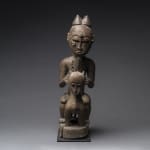Lagoons Region Sculpture of an Animal and Rider, 20th Century CE
Wood
height 44.5 cm
height 17 1/2 in
height 17 1/2 in
PF.3912 (LSO)
Further images
This dark and impressive sculpture of a horseman is a rare piece from the Lagoons region of the Ivory Coast. The human figure is in the traditional Lagoons style, with...
This dark and impressive sculpture of a horseman is a rare piece from the Lagoons region of the Ivory Coast. The human figure is in the traditional Lagoons style, with short, powerful legs, a long torso, slender arms and a head carved with exceptional care. The expression is serene, attained by the plain, looped brows, the closed eyes, the small, open mouth and the high brow, surmounted with a multi-conical coiffure. The ears lie flat against the head. The possession of a beard denotes age and thus social standing within the gerontocratic culture. The face is also decorated with several plugs of wood that fit into small holes drilled into the piece – these denote keloid scarifications. One might assume that the person represented is of high status, as not only is the figure somewhat masterful, but horses are always viewed as being elite possessions. The animal itself is actually more akin to a feline (i.e. leopard), in its high shoulders, sharp ears, short face and almost human-like features. Alternatively it may be a therianthropic piece, a fusion of different animals into a character from Lagoons mythology. This would tend to lend the piece magical rather than status-linked importance. Both are covered with a dark and uneven patina implying handling and the application of libations.
The Lagoons people include about a dozen distinct groups, which are grouped into two main units (the Attye and the Ebrie), and are not usually confused with the Anyi, who are more influenced by local neighbours such as the Baule. Lagoons groups consider themselves to be distinct from one another except in cases of threat, when they combine. Their social structure is based upon a gerontocracy. Artistically, they are defined by carvings of astonishing refinement, with exceptionally serene expressions and attenuated proportions. They usually have highly ornate hairstyles, keloid scarifications – rendered as removable plugs – and glossy patinas from usage. The figures were used by spiritual intermediaries to obtain information from the hereafter. There are also reports of highly gendered figures being used as spirit spouses, as in the Baule tradition. They are also said to have been display pieces at traditional dances, or awarded to excellent dancers and performers. They are sometimes adorned with beads, which are often more diagnostic in terms of area of origin than the piece itself.
Pieces such as this are rare, and are not described in the literature. Given the balance of elements, this is probably an ancestor or devotional piece, carved to show his power and authority. The meaning of the animal is equivocal, but likely refers further to his status. This is a powerful and attractive piece of African art.
The Lagoons people include about a dozen distinct groups, which are grouped into two main units (the Attye and the Ebrie), and are not usually confused with the Anyi, who are more influenced by local neighbours such as the Baule. Lagoons groups consider themselves to be distinct from one another except in cases of threat, when they combine. Their social structure is based upon a gerontocracy. Artistically, they are defined by carvings of astonishing refinement, with exceptionally serene expressions and attenuated proportions. They usually have highly ornate hairstyles, keloid scarifications – rendered as removable plugs – and glossy patinas from usage. The figures were used by spiritual intermediaries to obtain information from the hereafter. There are also reports of highly gendered figures being used as spirit spouses, as in the Baule tradition. They are also said to have been display pieces at traditional dances, or awarded to excellent dancers and performers. They are sometimes adorned with beads, which are often more diagnostic in terms of area of origin than the piece itself.
Pieces such as this are rare, and are not described in the literature. Given the balance of elements, this is probably an ancestor or devotional piece, carved to show his power and authority. The meaning of the animal is equivocal, but likely refers further to his status. This is a powerful and attractive piece of African art.
Literature
V19







